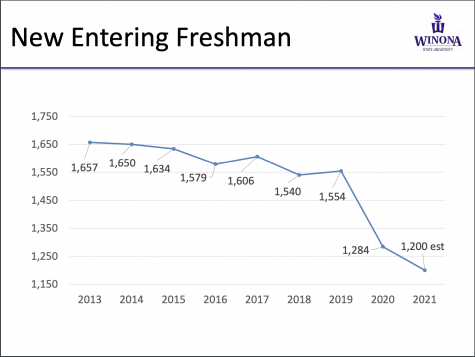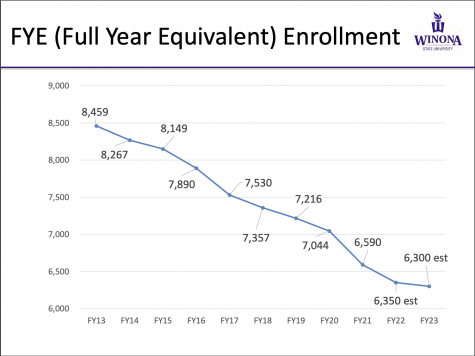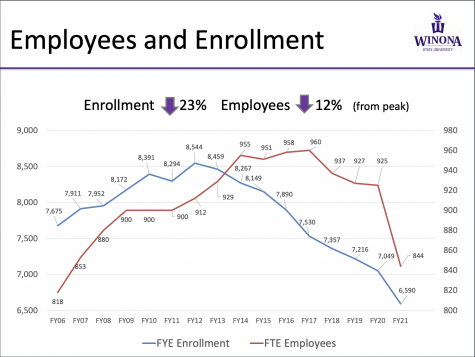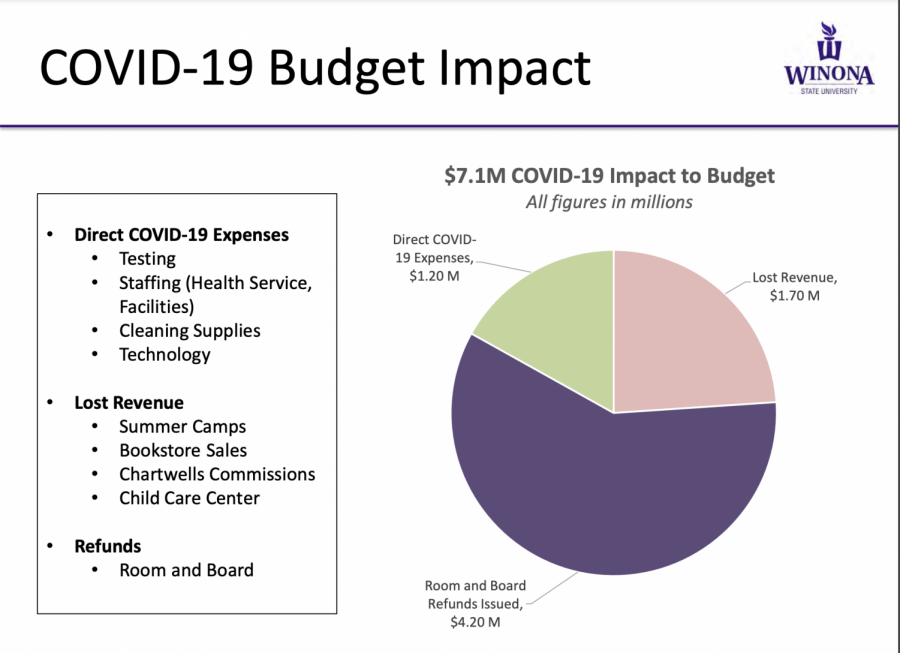WSU budget deficit worsened by COVID
November 4, 2020
Winona State University held its first all-university budget forum of the school year on Thursday, Oct. 29 to address its ongoing and increasing budget deficit.
Winona State announced its $1.6 million budget deficit last fall through an email sent to university faculty from Winona State’s chief financial officer, Scott Ellinghuysen.
The university had then predicted a worse budget situation for this year, the worst-case-scenario estimated near $6 million, last spring.
The COVID-19 pandemic was an unforeseen factor that has largely affected that worst-case-scenario number.
This year, the worst-case-scenario totals at an $8.5 million budget deficit.
The budget forum was led by a panel of Winona State’s administrative leadership members, including university president Scott Olson, Ellinghuysen, the vice president for student and life development Denise McDowell and others via Zoom.
Ellinghuysen led the online meeting through roughly 30 PowerPoint slides that included graphs and charts displaying enrollment statistics, employee statistics and present and future concerns the university has regarding the budget, among other topics.
Like last year’s budget forums, Ellinghuysen presented three budget scenarios for the fiscal year (FY) 2022, simply called A, B and C.
Scenario A is the worst-case-scenario of an $8.5 million deficit.
Scenario B estimates a deficit of $5.7 million.
Scenario C estimates a deficit of $3.2 million.
These estimated deficits are up from last year’s budget scenarios, which included budget reduction plans for either $3, $4 or $6 million for FY21.
Each scenario’s estimated loss is based on a culmination of data from total revenue changes, total expense changes and total other/enrollment changes, shown in Ellinghuysen’s presentation.
In the beginning of the forum, Ellinghuysen shared how COVID impacted the university.
Ellinghuysen said that budget-wise, the university received about $5.7 million from the Federal CARES Act last spring, half of which went directly to student support.
Winona State distributed nearly $2.5 million from the CARES Act to more than 6,000 students, stated on the school’s website.
The other half of the CARES funding went towards institutional support.
Winona State spent nearly $1.2 million on direct COVID expenses, including additional staffing in health services and facilities, cleaning supplies and technology, Ellinghuysen said.
Alongside that, the school also lost about $1.7 million in revenue when COVID hit due to things like loss of bookstore sales, Chartwells commissions, the closure and reduced capacity of the childcare center, etc.
“When you look at the $1.7 million of lost revenue, the other big-ticket item we’ve had are the refunds that we had to issue students in our residence halls for room and board this past spring,” Ellinghuysen said. “That total is $4.2 million.”
Adding those three numbers together means the university spent around $7 million in COVID impacts.
The presentation listed several present and future concerns for the university and its budget, including the decline of high school graduates’ effect on enrollment and questioning of how COVID could permanently change enrollment patterns and university operations.

The final concern listed was that the university needs to implement “real structural change” since this will be the fourth major budget reduction Winona State has faced in the last five years.
Winona State’s full-time student enrollment has already been on the decline for nearly a decade.
After the school’s full-time student enrollment numbers peaked in 2012 at 8,544 students, those numbers have only gone down since. In FY20, there are roughly 7,000 full time students enrolled.
For FY21, that number drops to around 6,600 students.
Ellinghuysen’s presentation also showed estimated numbers for FY22 and FY23, the downward trend continuing to 6,300 enrolled, full-time students in FY23.
Olson noted that other universities in the Minnesota area are also facing similar issues, like going through restructure and change in how they recruit students.
“Competition, as a result, is getting very fierce,” Olson said.
Olson said that he recently found out that the University of Minnesota-Twin Cities will no longer required the ACT, SAT, essays or letters of reference.
In similar efforts, Concordia University in St. Paul recently slashed its tuitions by 35%, he said.
Other universities in the area like University of Wisconsin-Madison, UW-Eau Claire, UW-Lacrosse and others are also switching things up to try and adapt to current conditions and competition.
“[Winona State is] kind of a private college feel at a public university price and that’s a good place to be,” Olson said. “But that’s a place that is at risk because we are more selective than our state siblings. They [competing universities in the area] are going after our niche and so the question then becomes, “how do we preserve this niche?””
Also tied with Winona State’s declining full-time student enrollment numbers are full-time employee numbers.
Full-time employee numbers started increasing as full-time enrollment numbers dropped around 2012 and 2013 but have been in decline since around 2018.

Peak full-time employee numbers were at 960 in 2017 and steadily dropped down to 925 in 2020.
A sharp decline is projected to occur from FY20 to FY21, down to 844 full-time employees, based on the presentation’s graphs and charts.
Ellinghuysen said “[Winona State’s] biggest expense is people” last fall in regard to the university’s budget situation.
To try and handle that “biggest expense”, the university implemented the Board Early Separation Incentive Program (BESI) last spring to encourage specific faculty and staff members’ early retirement.
BESI offered eligible employees a monetary incentive if they entered early retirement, a budgetary move that offers a way to let faculty and staff move on from the university without implementing layoffs or other tactics.
Areas targeted were the colleges of Business, Education, Liberal Arts, Nursing and Health Science and Engineering.
Also targeted were those eligible in the business office, campus card/purple pass area, the library and Information Technology.
The university’s administration, athletic departments and the president’s office were among those not targeted for the BESI.
Last spring, chief human resources officer Lori Reed said 108 BESI offers were sent to eligible faculty and staff.
Soon after those offers were made, Ellinghuysen said just 24 of the 108 offers were accepted.
Last spring, Ellinghuysen said it was “really hard to say” whether layoffs would end up on the table or not in the future due to the budget situation.
However, during the Oct. 29 budget forum, a question came up in the Q&A chat asking if the university was talking about faculty or staff cuts at this point.
Olson said that while the possibility for layoffs hasn’t been “quite determined” yet, he is unsure if they can be avoided anymore.
“It’s very difficult this time around to see how any layoffs would be avoided, very hard,” Olson said. “Most of the things we could have done [to avoid layoffs] have already been done.”
Olson said that at the worst-case-scenario of an $8.5 million deficit, the university would “probably have to include layoffs.”
Last year’s BESI offer was made with a notice that there would be at least a three-year gap before the university could offer it again.
Ellinghuysen said that although COVID has changed the university’s situation, he does not know if the university could offer the BESI again this year, financially.
“We’ve actually talked about it at the Finance and Facilities Committee last week [and] given COVID and how the world has really changed from a year ago, is it [BESI] something we should look at now?” Ellinghuysen said. “Quite frankly, we don’t really have the reserves or the extra money laying around to offer the incentives.”
However, Ellinghuysen did say “nothing’s off the table. Everything, I think, is up for discussion.”
BESI offers accepted last year for either FY20 or FY21 will still be honored.
Olson and the rest of the panelists offered further time for Q&A’s towards the end of the forum where those in attendance suggested ideas to potentially help the budget situation.

Andrea Northam, interim vice president for university advancement and member of the President’s Cabinet, led the Q&A and shared the questions out loud.
One question shared asked whether the university would consider using athletic coaches as admissions counselors during their off-season.
Olson said that he could talk to the athletic director about it but would want to “gauge the comfort level of the coaches with that role.”
Olson also said that he knows “lots of students” come to Winona State because of its athletics programs and coaches. He said that student athletes have a higher graduation rate than the rest of the student body and that Winona State coaches “really are recruitment and retention specialists by another name” already.
Earlier in the forum, English associate professor Andrea Wood suggested the university recruit Film Studies and Mass Communication department students to work on promotional videos involving Winona State alumni for the school’s website and social media.
Olson said he would discuss the idea with Northam and McDowell.
Other topics during the Q&A included targeting potential first-year students who are not coming straight out of high school and if Winona State’s focus on safety guidelines regarding COVID were being received positively or not.
McDowell said more students have left student housing this year than at this time last year, but those students are still enrolled, likely leaving housing due to Winona State’s COVID restrictions on campus and in the dorms.
“I think history is still the verdict [on if] that was the best choice or not,” McDowell said. “I think it was the right choice morally to be as safe as possible. That was something the cabinet talked about. It was sort of like, well, of course we have to try to make this place as safe as possible.”
Olson also offered words of encouragement and acknowledgement of COVID’s effect on faculty, staff and students.
“I just want everybody to consider the stress you’re under yourself between your work life and your home and make sure that in the name of self-care, you are taking on things that are manageable,” Olson said.
There were around 200-300 participants throughout the hour-long budget forum.
Ellinghuysen said budget planning reviews will occur from Nov. to Feb. and the Student Fee Management Committee will meet Jan. to April to discuss the budget.
He said budget reduction decisions will be made between Feb. and March with a goal for the final budget reduction package to be made on or before March 1, 2021.
Ellinghuysen also said the university hopes to have budget reductions in place by July 1, 2021.
More public budget forums will occur around Feb. and March of 2021.
Additional information on the school’s budget situation can be found on the “Budget Toolkit” page of Winona State’s website along with a “Budget Suggestion Box” to submit further input and suggestions.













































